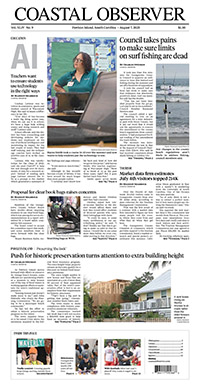Land use
Rezoning request sets up conflict with land use plan

A request to change the zoning for property along Highway 17 in Pawleys Island will require designating the site for high density residential development even though it is proposed for a medium density project.
A series of lawsuits and an ongoing update to the land use element of Georgetown County’s comprehensive plan have highlighted differences between the land use goals and what the zoning ordinance allows.
The zoning change that was up for review today by the Planning Commission underscores that. It is scheduled to be deferred after neighbors objected to the form of the change.
“I can assure you that we’re not going to support high density,” said Cindy Person, chief counsel for Keep It Green Advocacy, which has represented citizen groups and neighbors in four lawsuits over land use issues.
She is representing two adjoining property owners who oppose the zoning change.
The 19-acre tract is located between the Hammock Shops and the Village Shops. It includes 10.7 acres of marsh on Pawleys Creek that is zoned “conservation preservation.”
Another 5.1 acres is zoned “general residential.” The 3.2 acres along Highway 17 are zoned “general
commercial,” and the owner, David Tanner, is asking the county to change that to residential.
A plan prepared by the Earthworks Group for RCB Land Holdings of Conway shows a 26-lot subdivision called Magic Oaks.
The property was once owned by Reese Hart, a chemist, inventor and magician. He died in 1997 and is buried on the property next to his wife, who died in 1996.
Although the property contains three different zoning districts, the future land use maps that are part of the comprehensive plan show the entire site as conservation preservation. In order to rezone the commercial portion to residential, the county will have to change the future land use maps to high density.
“The proposed project and draft plans for 26 single-family lots meets density standards to be classified as medium density, but this is a straight rezoning, so if rezoned to GR it would possibly allow for high density development,” Matt Millwood, a senior county planning, wrote in a report to the commission.
The proposal works out to 3.13 lots per acre on the 8.3-acre residential portion. Anything over five units per acre is classified as high density. In addition, the general residential district allows multi-family as well as single-family units.
The solution to that problem is to create a “flexible design district,” said Person.
That would ensure that the property is developed for single-family lots and specify the number of lots.
“We’re not against development as long as its medium or low density,” said Kathy Reid, who lives on Pawleys Creek just north of the property. “We’re against high density development.”
Beth Martin, who lives on they south side of the property, shares that concern and also questions the impact of any development on wetlands and drainage.
Person said she contacted Earthworks to propose that the request be amended.
Without a zoning change, single-family lots can still be developed on property in a general commercial zone, but the lots must have at least 10,000 square feet.
The proposed plan for Magic Oaks shows lots as small as 8,400 square feet on the property up for rezoning.
If the zoning and future land use designation are changed, which requires three readings from County Council, the subdivision plan would also have to be reviewed by the Planning Commission for compliance with the development regulations.
A flexible design district would provide assurance to the neighbors, said Holly Richardson, the county planning director.
Although that recommendation isn’t included in the staff report, “that lends itself to discussion,” she said.
The planning staff isn’t sure why the entire tract is shown as conservation preservation in the future land use maps. They didn’t find any deed restrictions that would support the classification.
“Only the acreage of salt marsh should be designated this way because a single-family house already exists on the uplands,” Millwood wrote in his report.
He suggested that it could be an error in the county’s GIS map.
With the rezoning no longer on the agenda and no other business at hand, the commission cancelled its meeting.
Update: This article was updated from the print edition when the request was deferred after press time this week.




